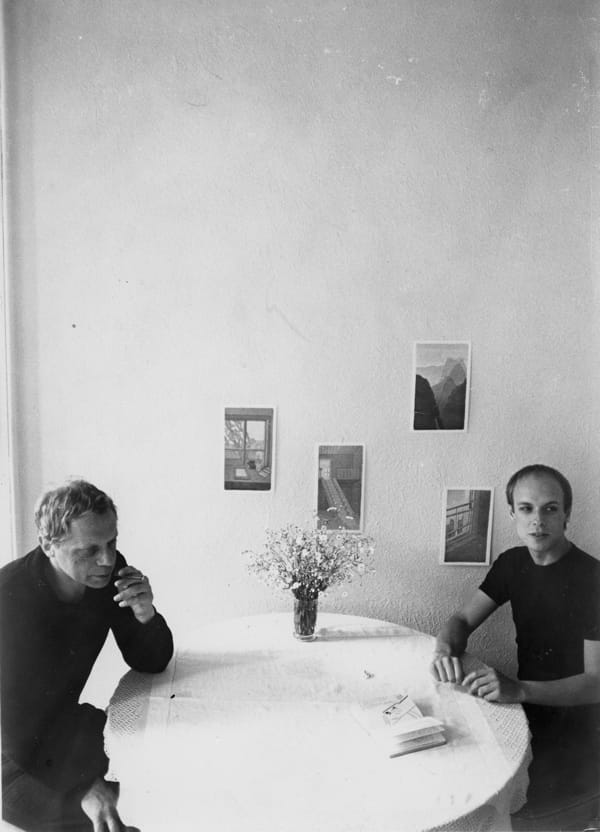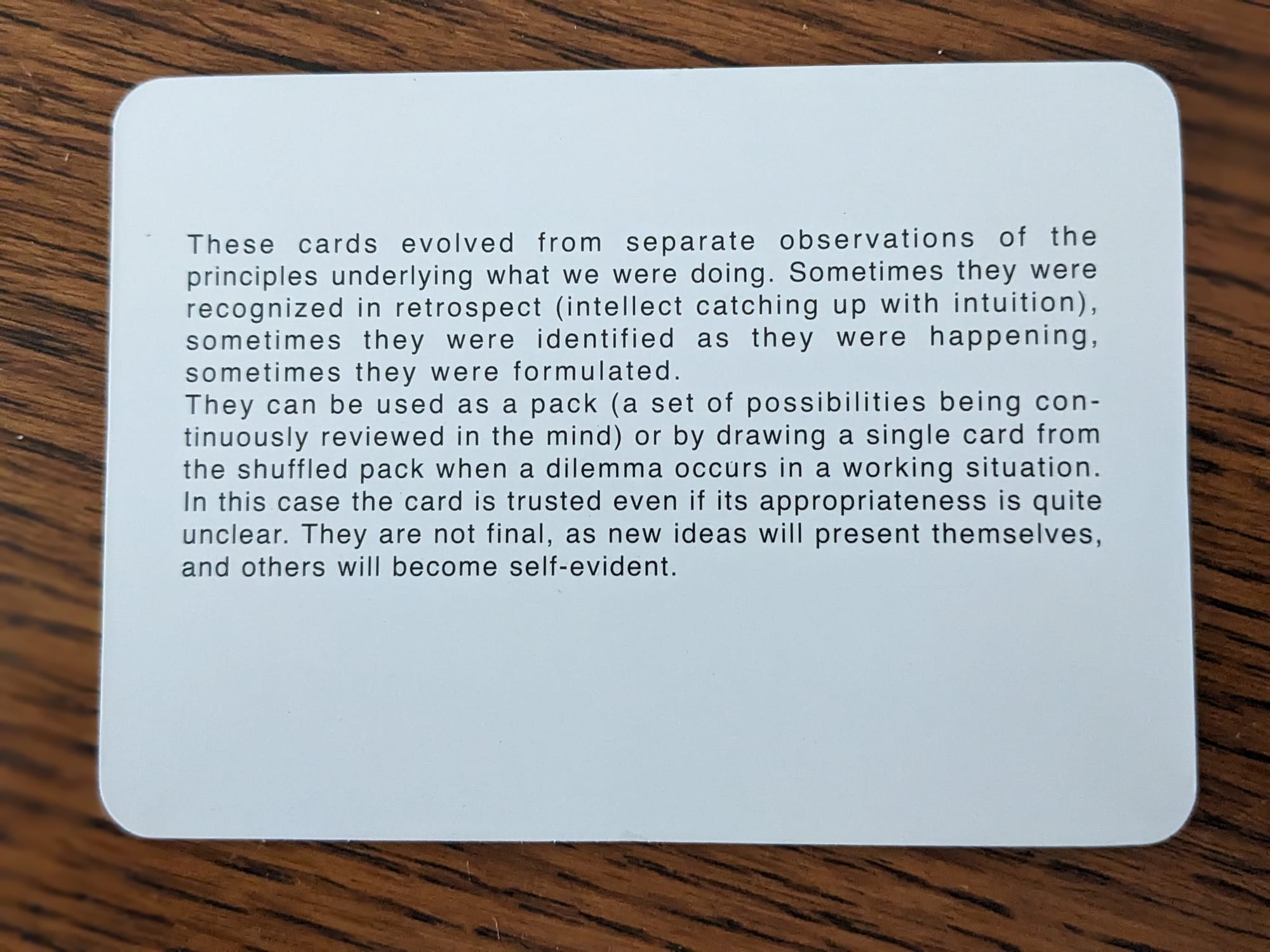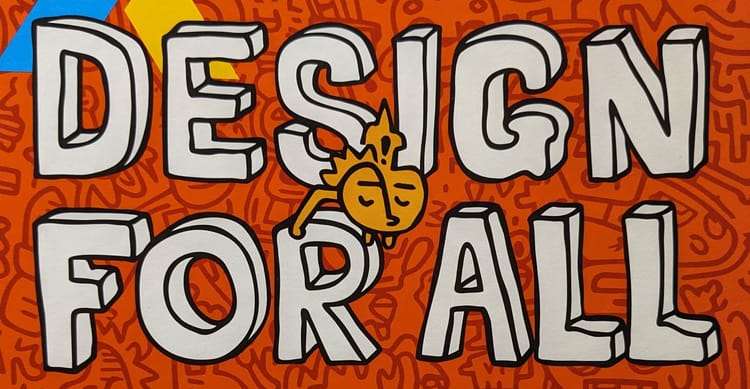Oblique Strategies

As far as design decks go, Oblique Strategies is one of “the big ones” and is often cited as inspiration for other, more recent decks. It was created by Brian Eno and Peter Schmidt in 1975 (six years after the DEW-Line deck from Marshall McLuhan) to help them work through creative ruts.
Brian Eno is an influential figure in experimental music, known for his pioneering work in ambient music, and his innovative production techniques with artists like David Bowie and U2.
Peter Schmidt (d. 1980) was an accomplished multimedia artist and author (film, painting, sound design, books, etc.) and collaborated with Eno. When they met, they realized they both used little notes of prompts to help them work through things, and seeded what would become the deck.

I like this deck because it was created to fill a need: for not just one person but—independently—for two. I’ve often rolled the dice on a book or even a card deck, only to realize that they fell short because they were created as a marketable product first, and a valuable tool second.
The deck contains a title card and a (shockingly typeset) instruction card. The first way to use the deck involves removing multiple cards from the deck, one at a time. This becomes a series of possibilities to be “reviewed in the mind”. I find this is how I use the deck more often than not—like a bit of a checklist.
The second method involves drawing a single card and letting it guide your path, incongruity be damned. This approach requires more discipline but can produce some interesting breakthroughs (or at least expand the possibilities). This act of reconciliation forces you to relate the aphorism to a challenge in new and different ways; it can be frustrating.

These cards work for everything
The deck is domain-agnostic—they don’t care what you’re working on. The language is plain and succinct, which makes them practical and easy to use.
Luckily, there aren’t many cards that come across as truisms or cliché. In contrast, the DEW-Line deck seems to suffer from inaccessible phrasing and aphorisms that you need to spend too much time interpreting to be useful.
Some of my favourite cards
The cards were created by two creatives to help with their multimedia and music production work, but many of the cards have helped with my product and user experience design work.
Recognizing this point of view (and its bias), here are some of my favourite cards.
“Where’s the edge? Where does the frame start?”
If you know me, you’ve likely heard me talk about exploring the boundaries of a problem space to figure out where the edges are before jumping into solving something. I learned this idea from Abby Covert in her book, How to Make Sense of Any Mess and think this card aligns nicely.
Two other cards which seem related to this one:
- “Go to an extreme, move back to a more comfortable place”
- “Which frame would make this look right?”
“Don’t break the silence”
This one always reminds me of Steve Portigal and his advice around working with silences during research interviews (from Fluxible 2013). This technique is also one that facilitators are familiar with and need to master: ask a question of a reticent group and then just…wait.
Other times this card makes me think of reducing (figurative) background noise, making space for just being present (listening vs. speaking), or the value of (mental? typographic? design?) white space.
“Remember .those quiet evenings” [sic]
This card is very interesting to me as it is, as far as I know, the only one with unusual typesetting. I’m still not sure if it is intentional (if it is, I’m not in on the joke) or if it is just a typo. This is the 5th edition; surely if this was a mistake it would have been corrected by now, right?
“Try faking it!”
This challenge is credited to Stewart Brand, who is a fascinating person with an enviable body of work (Whole Earth Catalog, The WELL, MIT Media Lab, etc.). I wish I knew how this aphorism made its way from Brand to the deck, especially with “fake it ’til you make it” becoming a bit of a tech worker mantra.
“Are there sections? Consider transitions”
This card asks you to confront the topology or architecture of your work. You need to understand the nouns and the verbs, the islands and the ferries…the subway map of it all.
Sometimes I think about wayfinding and how to move between pages in a mobile app. Sometimes I think about an onboarding flow. Sometimes I think about service design and whether I’ve considered all the paths (of inquiry, of people along their journey, etc.).
For me, this card usually means drawing diagrams.
“Give way to your worst impulse”
I love the efficiency of this phrase. Every bit of it is adding value:
- “Give way” evokes a feeling of yielding to a force of nature.
- ‘Your’ makes it personal. And, if there are others playing along, brings in different perspectives.
- ‘Worst’ means you have permission to push things to the extreme; this isn’t just a bad impulse, it’s the worst impulse. Thinking about extremities is a great way to break through, even if you can’t get there just yet.
- Impulses tie to our gut, to our intuition. So maybe this card grants permission to listen to the faint signals we've noticed recently.
I’ve been trying to build more critical exploration of worst-case product uses into my design work recently; this card seems to align with that. How can someone corrupt your product to be used for evil? What's the disaster scenario for issues of trust around privacy or data?
“State the problem in words as clearly as possible”
The pattern of expansion and contraction plays out everywhere, including in the work behind the work: the process you use for product definition and development. Sure, get expansive when talking about a feature, product, etc., but then distill things down to their essential elements.
Don’t be afraid to spend some time on wordsmithery; language matters (see the notes around “Give way to your worst impulse”, above, for a taste of what I mean).
A related card seems to be:
- “Do the words need changing?”
“Not building a wall but making a brick”
In a past life as a software developer, I thought about this sort of thing a lot: Am I building a component or a system? This card always makes me re-evaluate what it is I think I’m building (wall vs. brick; system vs. component; etc.).
Honourable mentions
“Is it finished?”
Is it good enough to help answer the question you’re asking? Are you still working on it for selfish reasons?
“Take away the elements in order of apparent non importance” [sic]
Subtractive design is good design.
“Distorting time”
The project I’m working on right now involves longitudinal data collection, analysis, and visualization; time plays a big role. I need to consider whether my mental model is a) accurate and b) is reasonable for someone else to adopt or learn to be successful with the product.
“Honour thy error as a hidden intention”
Reframe a mistake as an opportunity…or at least consider why you might have made the error.
“Would anybody want it?”
I mean, this should be the only card in a one-card deck of product questions.
“Make something implied more definite (reinforce, duplicate)”
For me, this is about clarity, but also about reducing the cognitive load for people.
“Who should be doing this job? How would they do it?”
Get outside yourself and the constraints inherent to your role. I’d say imagine what someone might do, but it is better to just ask them.
“What wouldn’t you do?”
I’ve always thought of this question as an ethical one. Think about where you'd draw the line during your product design work and, ideally, discuss that with your team before you’re put to the test.



